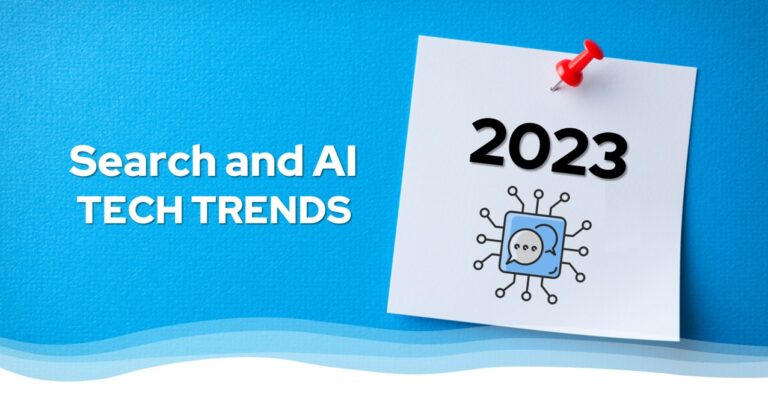

Phil Lewis
Last year we published our first blog on Search and AI Tech Trends for 2022 and we were arguably correct in all seven predictions. In 2023, changes in AI and search will continue to happen at a breakneck pace. As always, we try to focus on pragmatic developments and trends that can impact your plans to develop search-based applications in the near-term versus anything too overhyped, or immature and impractical to deploy. So without further ado, here are our Top Tech Trends in AI and Search that you should pay attention to in 2023.


1. The Search Market is Healthy and Evolving
We’ve seen new search solutions from OpenSearch, MongoDB Atlas Search, Pinecone and Vectara. These and other vendors emerged because the sources and volume of structured and unstructured data continues to grow exponentially. This drives market demand for innovative commercial and open source search solutions to search and analyze all this data.
2. Vector Search for Text Queries Becomes Mainstream
As the amount of text content continues to explode, vector search capabilities are becoming mainstream. Most traditional search solutions (like Coveo, Elastic, Sinequa and even Solr) have added this enhancement to their platforms. New emerging solutions (mentioned above) are almost exclusively focused on vector search / dense vector search. We also note that this technology is also referred to as “neural search” which is more conducive for marketing purposes and attracting VC money.
3. AI Models like GPT3 and its ChatGPT Interface Normalize “Conversational” Search
Last year we said seamless, human to AI “conversations” were not there – yet. But the emergence of Large Language Models (LLMs) like GPT3 and its chat interface, ChatGPT are creating quite a stir. Google these terms yourself and you will find articles that leave you equally amused, impressed – and concerned.
In the former case, you can ask ChatGPT to “write a biblical style verse explaining how to remove a peanut butter sandwich from a VCR”. But there are valid concerns about students cheating on essay assignments. Longer term concerns include the elimination of coding and writing jobs or built-in cultural or gender bias in these models that impact the content generated.
The fact of the matter is, ChatGPT has brought conversational AI into the public consciousness. This technology and others like it (see Google MUM) will mature. This will normalize the expectation that search application interfaces should mimic a natural language conversation.
4. Bleeding Edge AI Models Become Prohibitively Expensive for Most
Then there is the pragmatic issue of how to deploy NLP tools and LLM models in a search application. One immediate challenge is that models like GPT3 and even Google BERT are “closed” so organizations usually have to extend or train them on different data. This involves the vector search / neural search capabilities we alluded to, which are getting more powerful but require huge storage and compute power. The trend is towards using commercial cloud-based models for your NLP needs but watch out as this can become expensive very quickly. We’ll see what kind of business model emerges for commercial third-parties or industry associations to try to do this more cost-effectively than each enterprise creating their own extended language models from scratch.
5. Text NLP is Underutilized as an AI tool Despite Maturing Rapidly
While LLMs and conversational AI address the “front end” of search applications, we can’t ignore that advances in traditional Natural Language Processing (NLP) tools have matured and are being applied to understand and analyze text content. The latest established tools and techniques are excellent but are still woefully underutilized.
Besides early use implementations to automate customer service and technical support, new use cases are emerging like social media monitoring, competitive intelligence and internet-based customer prospecting. Now is the time to “get on the train” to leverage the latest in text NLP for competitive advantage.
6. Knowledge Graphs and Semantic Models are Still Important
Some industry “experts” have predicted that AI models may mean the demise of traditional knowledge management or the end of the need to organize or pre-process data for search. The reality is we still benefit from the authoritative “predictability” and efficiency that these technologies and disciplines bring. In fact, taxonomies, semantic models and AI are finding ways to co-exist and complement one another: The Future of AI: Machine Learning and Knowledge Graphs (neo4j.com).
7. Hybrid Search Combining Traditional and AI-based Technologies Still Works Best
AI language models like GPT3 and MUM are getting all the hype. But we believe that a “hybrid search” approach using both traditional keyword-based search and AI-driven technologies will be the most pragmatic model going forward. My two cents says that a seamless merging of text and vector search in the same engine is a better way to go than just relying on vector search. This is well illustrated in this this excellent presentation on hybrid search by Lester Solbakken at Berlin Buzzwords this year.
I hope you enjoyed my latest practical prognostications on key tech trends in AI and Search for 2023. I can’t emphasize enough how dynamic and exciting this space is right now, but that can also make it tremendously daunting and confusing from an implementation perspective. As always, Pureinsights is here to help, with a focus on what’s best for our customers. If you have any questions, please CONTACT US or drop me a note at info@pureinsights.com.
Best regards and Happy New Year to all!
– Phil